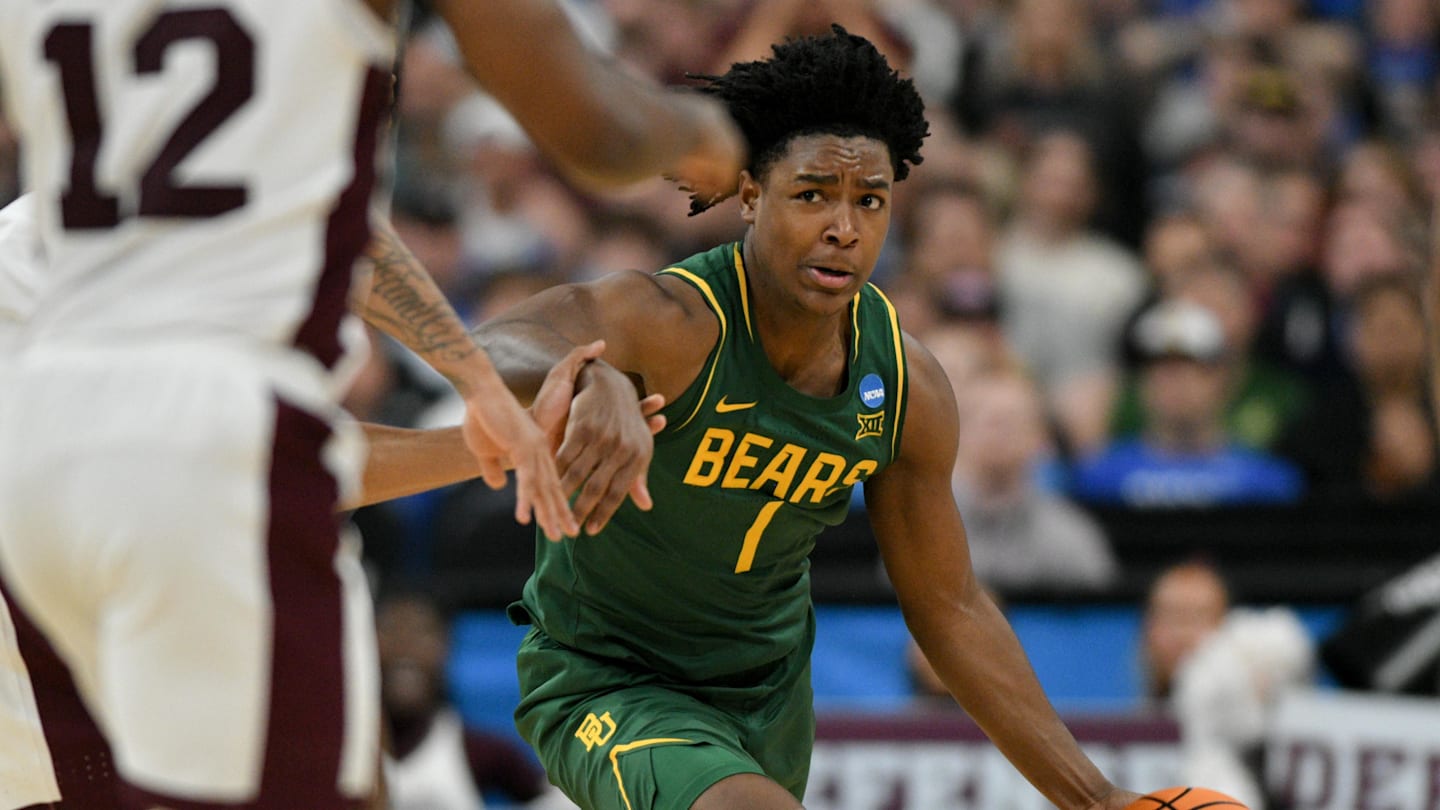Hope so because we now have four 4s and not a single true 5 on the roster. Would prefer not to play small ball full-time if we can avoid it.https://x.com/gmurecruiting/status/1912612609582412154?s=46&t=SPAULOBHtYuHTegQzAwSjg
Ellington committed to Mason. I wonder if Mason will go after another big man?
You are using an out of date browser. It may not display this or other websites correctly.
You should upgrade or use an alternative browser.
You should upgrade or use an alternative browser.
2025 Portal Season
- Thread starter bravesfan
- Start date
FreeGunston12
All-American
Ellington is an interesting pick up for sure, but I wouldn’t call him a 4 . . . not in Tony’s system. Ellington has not attempted a 3 in his college career. Kanga doesn’t seem to have that perimeter skill set either.Hope so because we now have four 4s and not a single true 5 on the roster. Would prefer not to play small ball full-time if we can avoid it.
I hope we can find a Gio-like presence to battle the big bodies when needed, but I think we are going to be seeing a lot of the aforementioned at center next year.
makes me wonder what the GMU approach is?
Men’s Basketball Transfer Portal: With One Week to Go, Latest on How 2025–26 Season Is Shaping Up
The pending House settlement had an impact on the portal and many teams are getting creative in building their rosters.www.si.com
"Roster Construction Philosophies Vary
The pending House settlement’s changes to how rosters will be constructed has had a significant impact on the portal. Teams can roster 15 players going forward, but all 15 can be on scholarship instead of the old 13-scholarship cap. That said, just because all 15 may receive a scholarship doesn’t mean staffs will allocate precious revenue share and NIL dollars to players at the back end of their rosters. Even the biggest budgets nationally, believed to be just north of $10 million for a handful of top-tier programs, can vanish quickly if spread around 12 to 15 players. Some will operate with a traditional 12 to 13 players and allow their walk-ons to stay on the team in those final few roster spots; others may take it even further and focus all their resources to nine or 10 players and backfill the remaining roster spots with dart throws. You’ll see very few teams fill all 15 roster spots with players talented enough to make a real impact that season, both for budgetary and also chemistry reasons.
One high-major staff I spoke to this week has spent its entire budget on nine players and is now looking for two to three freshmen or transfers who’d come for nothing other than a scholarship, which are extremely hard to find in this day and age. Some staffs have saved a few dollars here and there for those end-of-bench filler pieces, referred to by some GMs and personnel staffers as “minimum contracts” that often end up in the $100,000 range to woo freshmen or junior-college players who’ll largely serve as developmental pieces and practice bodies. But those end-of-bench value pieces can sometimes end up becoming critical role players after injuries or missed evaluations blow up projected rotations, so keep an eye on those moves around the margins.
Big picture though, there has been an emphasis in conversations with several top assistants and GMs on avoiding overpaying for players projected to come off the bench. One program I spoke to earlier this cycle said they wanted to ensure they spent 75% of their overall budget on their projected starting five after spreading their dollars around far too much the previous year, and that general framework is something that has been echoed in a number of conversations in recent days and weeks. The thinking: Spending $500,000 each on two mediocre wings is less efficient than betting big on a $700,000 or $800,000 potential high-level starter and using a developmental piece in the $200,000 range behind them."
we will fnd out soon - after the next 2 players join the team
emjayar08
Starter
Yaak Yaak!Ellington is an interesting pick up for sure, but I wouldn’t call him a 4 . . . not in Tony’s system. Ellington has not attempted a 3 in his college career. Kanga doesn’t seem to have that perimeter skill set either.
I hope we can find a Gio-like presence to battle the big bodies when needed, but I think we are going to be seeing a lot of the aforementioned at center next year.
The coaches and schools voluntarily agree to those buyouts, so, I feel no sympathy for the coaches on that. The buyouts are, typically, woefully inadequate, though.Also a huge double standard that coaches have to buy their way out of their contracts while players can change schools or decide to stop playing (ooh my ankle has an ouchie!) at any time with zero accountability or consequences.
Just like the portal restrictions/requirements, that is also because of the NCAA. Since they don't allow NIL to be tied to what school you go to or the fact that you are playing, there is nothing to tie a buyout too. If they could do it, the schools/collectives/business would put buyouts in the contract and the players would accept them as part of the negotiations.
That’s true, he is a post player but he’s an inch shorter than Jalen and we saw the trouble he had going up against length last season. Gotta believe Ellington will be utilized differently to maximize his effectiveness.Ellington is an interesting pick up for sure, but I wouldn’t call him a 4 . . . not in Tony’s system. Ellington has not attempted a 3 in his college career. Kanga doesn’t seem to have that perimeter skill set either.
I hope we can find a Gio-like presence to battle the big bodies when needed, but I think we are going to be seeing a lot of the aforementioned at center next year.
illayin
Sixth Man
ellington feels like a haynes type to me. slightly undersized height wise but can use his body to create space for himself downlow and he can handle the ball and get to the basket confidently in a 5 out offense. i can imagine the defensive intensity being similar from the highlights i've seen. i don't see an issue with him playing the 5 on a CTS team.
NewPatriot
Starter
Hope so because we now have four 4s and not a single true 5 on the roster. Would prefer not to play small ball full-time if we can avoid it.
Steve curran is hunting alot of 6'11 - 7 footers in the portal right now.Ellington is an interesting pick up for sure
I hope we can find a Gio-like presence to battle the big bodies when needed, but I think we are going to be seeing a lot of the aforementioned at center next year.
One such centwr on his radar for 3 weeks..Emeka Opurum. He just signed with auburn...soon after..the list of other schools after included George Mason.
NewPatriot
Starter
Some other 6'10 - 7 footer names to keep in mind
Dame Salane, Christian Nitu, Kasean Faulker-Smith, Arrington Page, Yuto Yamanouchi-Williams.
Dame Salane, Christian Nitu, Kasean Faulker-Smith, Arrington Page, Yuto Yamanouchi-Williams.
Saw this on vcu ram nation posted around 1pm:Anyone know how were are doing with our haul of portal players vs our A10 peers?
"vcu now has 4 guards (Jennings, Hill, Nowell and Tracey). There is still a possibility that Zeb Jackson could come back. vcu also has a Zoom call schedules with 6'2" Deyton Albury this week. Tillery is also 6'5", but listed as a SF. Seems to me the focus now should be at front court positions. Right now, vcu only has Fermin (6'10"), Mitchell (6'11") and Evans (6'8") in the front court. I would feel better if Bamgboye was coming back, but that doesn't seem to be happening. Also, no word on Belle yet. Also thinking Fats doesn't fit into Martelli's plans since there is also no word on him yet."
Not as organized and systematic as to what's been posted on Mason's transfer portal, so take it for what its worth.
Pablo
Hall of Famer
Anyone know how were are doing with our haul of portal players vs our A10 peers?
Atlantic 10 Rosters 2025-26
Whoa! Impressive work--are you the author of this?
Atlantic 10 Rosters 2025-26
docs.google.com
Opurum was offered back in DecemberSteve curran is hunting alot of 6'11 - 7 footers in the portal right now.
One such centwr on his radar for 3 weeks..Emeka Opurum. He just signed with auburn...soon after..the list of other schools after included George Mason.
Of these, Arrinten Page would be my preference by a wide, wide margin, although I’d love Salane as a developmental prospect.Some other 6'10 - 7 footer names to keep in mind
Dame Salane, Christian Nitu, Kasean Faulker-Smith, Arrington Page, Yuto Yamanouchi-Williams.
Pablo
Hall of Famer
NoWhoa! Impressive work--are you the author of this?
Awesome. Can we make this a Sticky on the boards for easy access.
Atlantic 10 Rosters 2025-26
docs.google.com
Thx
I trust Skinn, but this roster feels really different. Last year, it was mostly guys who had made an impact at the P5 level. This year, it’s more players who stood out at smaller programs.
"NIL feels a lot like the real estate market. Last year, I could get a solid single-family home for $600K. This year, that same budget barely gets me a shoebox. The prices have shot up, and the value just doesn’t stretch as far anymore.
"NIL feels a lot like the real estate market. Last year, I could get a solid single-family home for $600K. This year, that same budget barely gets me a shoebox. The prices have shot up, and the value just doesn’t stretch as far anymore.
p8triotfan4life
Starter
I trust Skinn, but this roster feels really different. Last year, it was mostly guys who had made an impact at the P5 level. This year, it’s more players who stood out at smaller programs.
Tony plucked the top player on each team this cycle (sans Long) and each are going up a level. I admire this approach. My coworker is a diehard Maryland fan and said that Long is a good defender. I just hope this new team gets a chance at a summer tour to jell.
Awesome. Can we make this a Sticky on the boards for easy access.
Thx

A10 Rosters 25-26 Spreadsheet on Google
https://docs.google.com/spreadsheets/d/1j_LyW0_d70G0RgVApJbwdJKDlE0TknB_1CG8Q_HMto4/edit?pli=1&gid=1912864654#gid=1912864654 Per @TweederGMU request, hat tip to @Pablo for sharing the link. Locking the thread so that discussion can continue in the 2025 Portal Season thread.
Made a thread and made it sticky with it locked so that talk can continue here.
Top Donors
-
Patriotsince81$250.00
-
GSII$100.00
-
Old Man$100.00
-
hoopsjunkie75$50.00
-
GMU1983$50.00
Forum statistics
#MasonNation Network
Check out these great sites:
GiantKiller.co
ByGeorge
Expat Hoops
Fourth Estate
Doc Nix and the Green Machine
Bill Bride - DMV Sports Shots
Patriot Brew Blog/Newsletter
GiantKiller.co
ByGeorge
Expat Hoops
Fourth Estate
Doc Nix and the Green Machine
Bill Bride - DMV Sports Shots
Patriot Brew Blog/Newsletter
